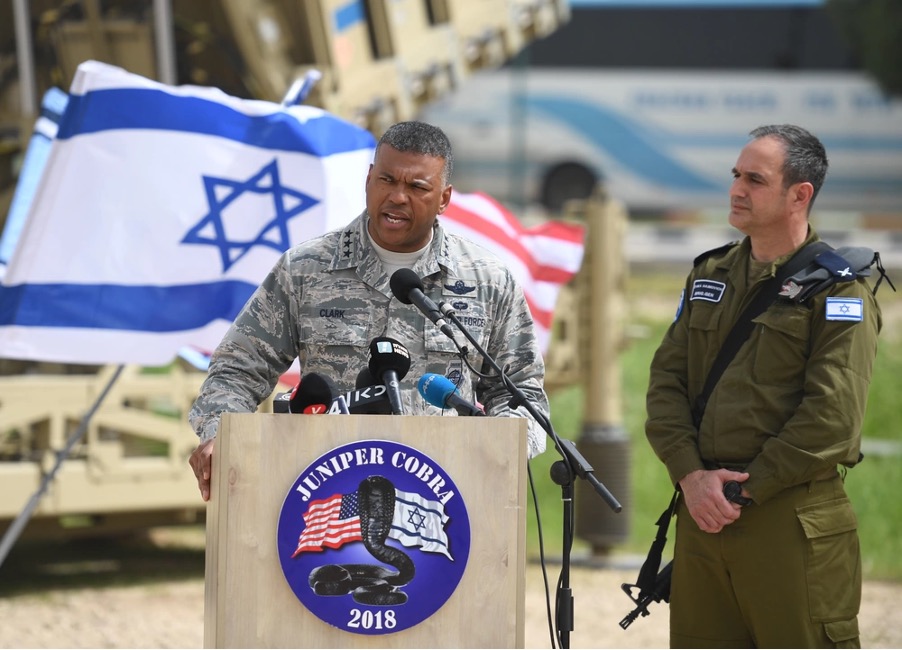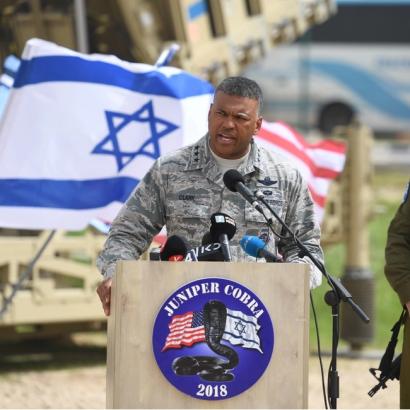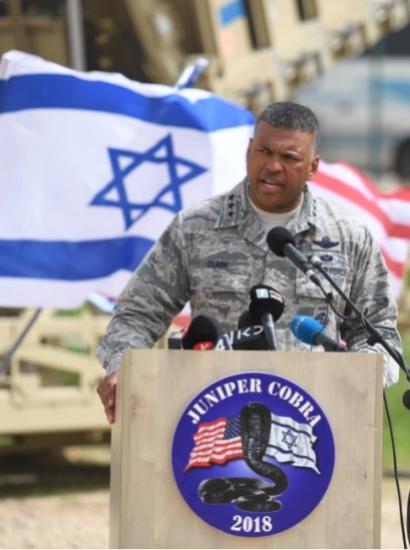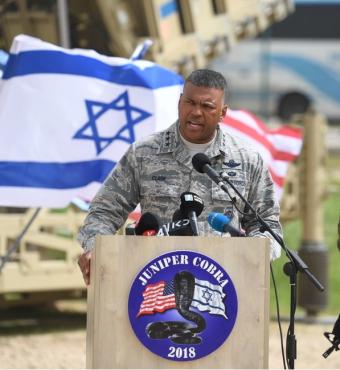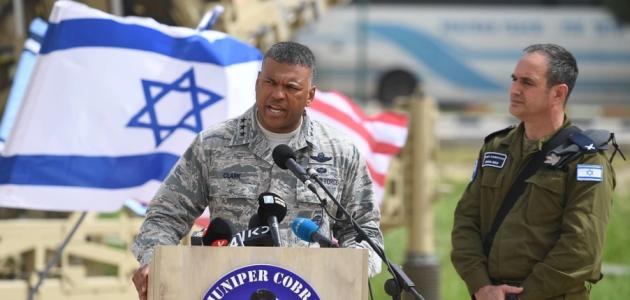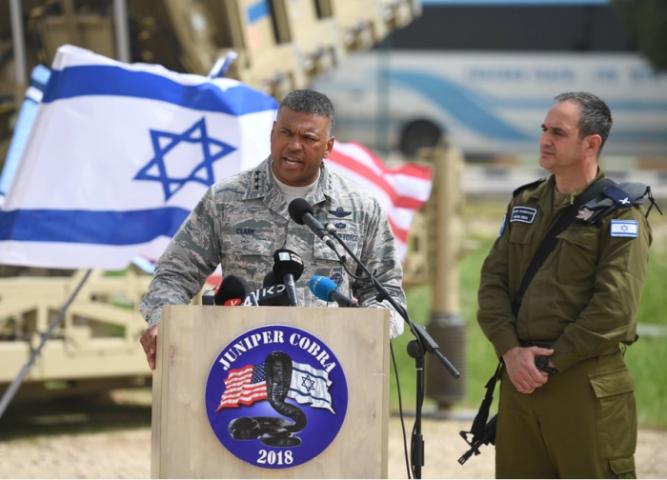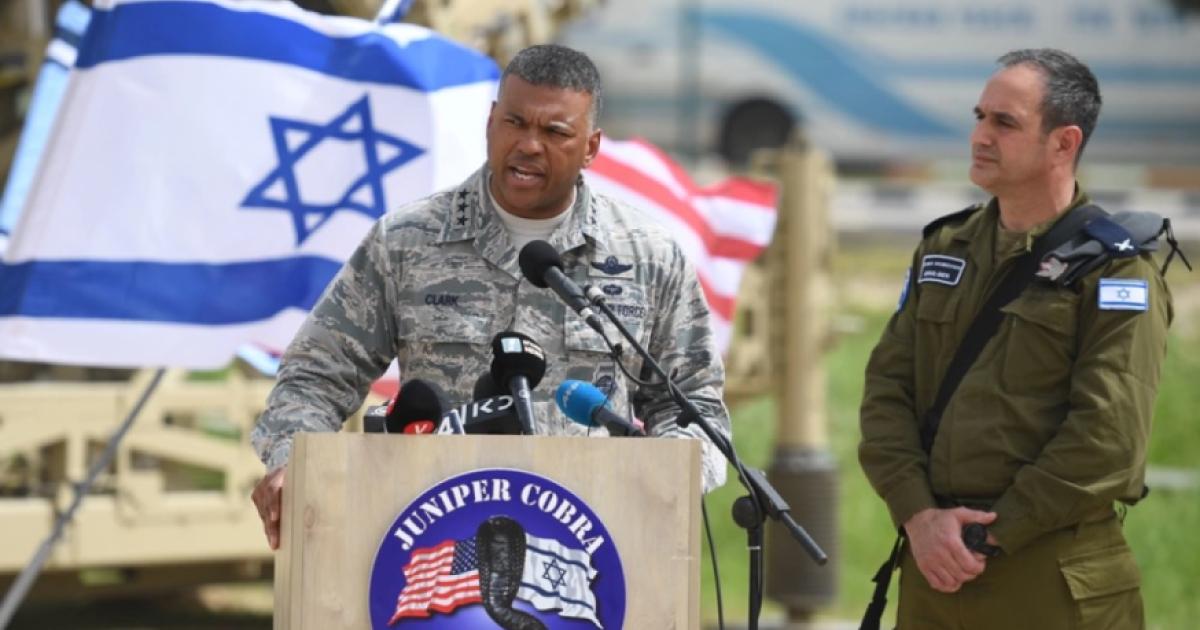Austere Challenge. Juniper Cobra. Juniper Oak. Juniper Falcon. Nonsensical terms to most people. But for those involved in US-Israel defense cooperation, these are code names for a series of combined exercises between Israel and the United States held over the past few decades. The focus of these exercises has been Theater Missile Defense (TMD). Juniper Falcon and Juniper Oak were last held in early 2023. Juniper Oak involved 6,400 US troops alongside 1,500 Israeli troops and more than 140 aircraft; it was the largest-ever combined exercise between the two countries. On April 13, 2024, years of such work paid off handsomely with an astounding display of interoperability, successfully defeating a massive Iranian missile and drone attack on Israel.
The October 7th War, which began when the Palestinian Hamas terrorist organization invaded Israel from Gaza, is only a localized iteration of a wider struggle that pits Israel, the United States, Europe, and the moderate Sunni Arab countries against the “Axis of Resistance” led by Iran and its regional allies and proxies, such as Syria, Hizballah, Iraqi militias, Palestinian Islamic Jihad and Hamas.
The leaders of Israel, the United States, and the pragmatic Sunni Arab countries of Egypt, Jordan, and the Persian Gulf, realized many years ago they shared a strategic threat first from Iranian missiles, and later drones. Israel was the only country without a defense treaty with the US to be invited to join President Ronald Reagan’s Strategic Defense Initiative (SDI), which it did in early 1986. Dubbed “Star Wars” by the press, SDI changed with the times and became a ground-based missile defense program during the Clinton Administration. Today it is under the Missile Defense Agency, which cooperates with Israel’s Missile Defense Organization.
With significant military assets of its own in the region, and Gulf allies and Israel to protect from Iran, the US sought to develop a TMD regional security architecture. US land-based missile defense systems such as small-area defense Patriot and middle-tier Terminal High Altitude Area Defense (THAAD) were spread among Arab allies and Israel. US Navy Aegis missile defense-equipped ships were dispatched to the Mediterranean, the Persian Gulf, and the Red Sea when needed.
Israel itself became the regional leader in the development of TMD, and a real-world experimental laboratory. Israel deploys the low-tier Iron Dome system with great success.
Initially a sole Israeli effort, in 2011 the US began to contribute to its development and helped with procurement. Israel’s mid-tier system, David’s Sling, began to be co-developed with the US in 2008. Israel’s upper-tier defense system is the Arrow, which is co-developed and co-produced with the US.
From EUCOM to CENTCOM
While the need for cooperation in TMD was realized by all, the lack of full and open relations between Israel and the Gulf countries meant that coordination was often ad hoc. But both political developments and an increased Iranian threat boosted cooperation and demonstrated the need for better region-wide coordination.
From 2011-2023 Tehran and its proxies fired 3150 projectiles at US positions, Arab partners, and other allies in the region. In September 2019, Iranian cruise missiles and drones struck two critical Saudi oil installations, cutting Riyadh’s oil production in half. None were shot down. Yemeni Houthi missiles crashed into Riyadh, and even a Saudi royal family palace compound was hit in January 2021 with drones launched by Iranian proxy militias.
The Abraham Accords (September 2020), which brought about full normalization between Israel, the UAE, and Bahrain, made open cooperation possible. A high point in the developing regional security architecture was Israel’s 2021 joining of CENTCOM (Central Command), the American combatant command for the Middle East. Israel has previously been under EUCOM (European Command), due to Arab objections. It is highly likely though that TMD cooperation with the Gulf countries began even when Israel was under EUCOM.
Joining CENTCOM was a “game changer,” facilitating intelligence and early warning cooperation. A senior Israeli official stressed that joining CENTCOM had actually created a new alliance made easier by open technical cooperation. This held true, especially for Saudi Arabia, which had a key role in CENTCOM and faced an Iranian threat but had not signed the Abraham Accords.
At the Negev Summit in March 2022, a joint air defense system was discussed between the foreign ministers of Israel, the US, the UAE, Bahrain, Morocco, and Egypt. Later that month, CENTCOM Commander Gen. Kenneth McKenzie, Jr. held a secret meeting between top regional military officials at Sharm al-Shaykh, Egypt to discuss missile and drone defense against Iran. This was the first time such a meeting had been held.
By the summer of 2022, in the build-up to President Biden’s visit to the region, Israeli Minister of Defense Benny Gantz could speak of a nascent program of TMD cooperation which he dubbed Middle East Air Defense, or MEAD. He said that the plan has already thwarted Iranian attempts to attack Israel and other Middle Eastern countries. Yet the new architecture still had a long way to go, particularly in the area of intelligence and real-time threat data sharing. The combined US-Israel exercises held in early 2023, Juniper Falcon and Juniper Oak, brought coordination to new heights and likely involved Israel’s new Arab CENTCOM partners.
The Run-Up
Following Hamas’ October 7, 2023 invasion of Israel, and the attack on US assets by Iranian proxies, more systems were moved in or moved back into the region. These included THAAD to Saudi Arabia and additional Patriot batteries to Kuwait, Jordan, Iraq, Saudi Arabia, Qatar, and the UAE.
On April 1, 2024, Israel carried out a pinpoint attack on a building in Damascus where a meeting was being held between seven pivotal Iranian military figures, killing them all, including Gen. Mohammad Reza Zahidi, who oversaw Iranian proxy operations in Syria and Lebanon for the Islamic Revolutionary Guards Corps’ elite Quds Force. He was directly responsible for the Hizballah attacks on Israel that had been plaguing northern communities since October 7. On the same day, a mistaken Israeli drone strike killed seven World Central Kitchen charity aid workers in Gaza.
Each attack had a different context for the United States and its regional allies. The attack in Damascus was against a mutual enemy. In keeping with long-standing agreements, an Iranian response against the Israeli homeland would meet with a combined US-Israel defensive shield. But the Gaza attack came amidst great disappointment in the Biden administration with the humanitarian cost of the Gaza operation. Ties were at a nadir. While President Biden told Prime Minister Netanyahu on April 4 that world support for Israel had dropped following the attack on the aid workers, he nevertheless reassured Netanyahu that the US had Israel’s back against an Iranian attack on the Jewish state.
And Biden acted quickly, ordering the Pentagon to activate “highly classified plans for assisting Israel” in missile defense. The modalities for these plans were likely worked out during the years through combined military exercises. Despite fluctuating political tensions between Jerusalem and Washington, the defense establishments had learned to work together and even appreciate one another. Years of combined Israeli-American exercises were about to get their baptism by fire.
Secretary of Defense Lloyd Austin, himself a former commander of CENTCOM, placed the USS Carney and the USS Arleigh Burke in the Mediterranean. Both sported the Aegis Combat System and were equipped with several types of sea-to-air missiles, including the SM-3, which had yet to be used in a real-world situation.
Estimating that Iran would also employ swarms of drones, F-15E jet fighters joined F-16s already in the region. Jordanian and Saudi planes were placed on alert to defend their airspace. The USS Eisenhower aircraft carrier, which was already in the Red Sea operating against Houthi attacks on shipping was moved closer to Israel to allow its jets to intercept Houthi drones. CENTCOM commander Gen. Erik Kurilla landed in Israel on April 11, continuing on to coordinate from Jordan.
The Iranians launched their attack from Iraq, Syria, Iran, and Yemen in three waves. The first wave consisted of 150-185 drones, which was probably the largest swarm ever used in combat. This was followed by around 35 cruise missiles and 120-130 ballistic missiles. The Iranians hoped to overwhelm Israeli defenses—never had so many ballistic missiles been intercepted at once.
The Iron Shield
Israel dubbed the defense - Operation Iron Shield. The TMD architecture was coordinated by the US out of CENTCOM’s Combined Air Operations Center at al-Udeid Air Base in Qatar. It involved Israel, the UK, France, Jordan, and Saudi Arabia. Over Syria, the drones were shot out of the sky by Israeli aircraft and US F-15E Strike Eagles, the latter from the 494th Fighter Squadron out of RAF Lakenheath in Britain and the 335th Fighter Squadron out of Seymour Johnson Air Force Base in North Carolina. The US Navy’s Carney and Arleigh Burke downed four to six Iranian ballistic missiles, using their SM-3s for the first time in a real-world situation. A US Patriot battery in Irbil, Iraq, took out a ballistic missile headed towards Israel.
Israel’s own Arrow 3 intercepted most of the ballistic missiles. Here is a video of one such exoatmospheric interception. None of the cruise missiles entered Israeli airspace. Israeli defenses, probably F-35I fighter jets, downed most of them.
Of the Arab countries involved, Jordan took the most active role. This was not surprising. In 2004, King Abdullah II voiced his fear of the “Shi’ite Crescent” surrounding his country, and in July 2022 had given his support to a Middle Eastern alliance due to shared “threats.” The Royal Jordanian Air Force took out Iranian-backed drug and weapons smugglers in Syria in January of this year. The Jordanians downed several drones and missiles over its air space, as did Israel. The US coordinated this action. Jordan explained that it was protecting its airspace.
How much help came from Saudi Arabia? The Kingdom wasn’t really saying, but the usually reliable Roi Kais of Israel TV Channel Kan 11 quoted a source within the Saudi Royal family that would not deny that the Kingdom had helped repel the Iranian attack on Israel, “since any suspicious object intruding Saudi airspace would be immediately interdicted as a violation of Saudi sovereignty.” But US officials confirmed that Iran had informed both Saudi Arabia and the UAE of its plans, and this intelligence was passed on to the Americans and the Israelis. Real-time radar-tracking information was linked to the US operations center in Qatar. Riyadh allowed US aircraft stationed in the Kingdom to engage the threats from Iran.
The Saudis gave a hand because Iran is their strategic rival, despite the recent tactical resumption of diplomatic relations between Riyadh and Tehran. They expect the same protection from the regional TMD security architecture that Israel enjoyed on April 13.
Rounding out the missile defense were London and Paris. Britain shot down several drones over Iraq and Syria; France helped Jordan down drones over its air space.
Israel claimed overall a 99% success rate in neutralizing the Iranian threat, no doubt bolstered by the reported 50% failure rate of Iranian ballistic missiles Iranian ballistic missiles did succeed in hitting two Israeli air bases, Nevatim and Ramon, in southern Israel. Damage was minimal.
Israeli interest in both capitalizing on the excellent results of Operation Iron Shield and a desire to bolster increasingly difficult relations with the US over the October 7 War led to a measured but pointed Israeli counterattack on April 19. Israel destroyed an S-300 missile defense system at the Eighth Shekari Air Base northwest of Isfahan, which was likely involved in the defense of Iran’s nuclear program, demonstrating that it can carry out strategic bombing in Iran. It used a new locally developed supersonic air-to-ground missile, Rampage, that was undetected by Iranian radar.
The April 13 TMD defense of Israel was the culmination of years of preparation. It was “proof of concept” for regional cooperation and provided a rare real demonstration of US and Israeli technology. Although experts indicate that there is still more to be done in improving this regional security architecture, the security benefits are clear to all parties involved.







